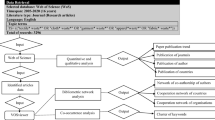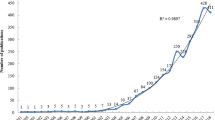Abstract
Waste printed circuit boards (WPCBs) containing various metals and hazardous materials are considered as a secondary resource and an environmental pollution source. A systematic overview of WPCB study was conducted by using CiteSpace. The relevant knowledge of 242 documents was collected from SCI-Expanded database (SCIE) and saved as txt files. A 556-node and 636-link network and 17 clusters were obtained. Based on co-citation network, nonmetallic material treatment and recycling, metal recovery, pyrolysis treatment, and new technology development were successively the most attractive fields in the study period. Timeline pattern showed that mechanical processing attracted great attention in the initial period and profitability assessment was the latest hot spot in WPCB study. The results could provide a reference for future work in WPCB field.


Similar content being viewed by others
References
Akcil A, Erust C, Gahan CS, Ozgun M, Sahin M, Tuncuk A (2015) Precious metal recovery from waste printed circuit boards using cyanide and non-cyanide lixiviants - a review. Waste Manag 45:258–271
Awasthi AK, Zeng X, Li J (2016) Integrated bioleaching of copper metal from waste printed circuit board—a comprehensive review of approaches and challenges. Environ Sci Pollut Res 23:21141–21156
Barontini F, Marsanich K, Petarca L, Cozzani V (2005) Thermal degradation and decomposition products of electronic boards containing BFRs. Ind Eng Chem Res 44:4186–4199
Birloaga I, De Michelis I, Ferella F, Buzatu M, Veglio F (2013) Study on the influence of various factors in the hydrometallurgical processing of waste printed circuit boards for copper and gold recovery. Waste Manag 33:935–941
Chen C (2006) CiteSpace II: detecting and visualizing emerging trends and transient patterns in scientific literature. J Am Soc Inf Sci Technol 57:359–377
Chen C (2012) Predictive effects of structural variation on citation counts. J Am Soc Inf Sci Technol 63:431–449
Chen C, Hu Z, Liu S, Tseng H (2012) Emerging trends in regenerative medicine: a scientometric analysis in CiteSpace. Expert Opin Biol Ther 12:593–608
Chen C, Dubina R, Kima MC (2014) Orphan drugs and rare diseases: a scientometric review (2000-2014). Expert Opin Orphan Drugs 2:709–724
Cucchiella F, D'Adamo I, Koh SCL, Rosa P (2016) A profitability assessment of European recycling processes treating printed circuit boards from waste electrical and electronic equipments. Renew Sustain Energy Rev 64:749–760
Cui J, Zhang L (2008) Metallurgical recovery of metals from electronic waste: a review. J Hazard Mater 158:228–256
D'Adamo I, Rosa P, Terzi S (2016) Challenges in waste electrical and electronic equipment management: a profitability assessment in three European countries. Sustainability 8:633
Duan H, Hou K, Li J, Zhu X (2011) Examining the technology acceptance for dismantling of waste printed circuit boards in light of recycling and environmental concerns. J Environ Manag 92:392–399
Ghosh B, Ghosh MK, Parhi P, Mukherjee PS, Mishra BK (2015) Waste printed circuit boards recycling: an extensive assessment of current status. J Clean Prod 94:5–19
Guo J, Li J, Rao Q, Xu Z (2008) Phenolic molding compound filled with nonmetals of waste PCBs. Environ Sci Technol 42:624–628
Guo J, Guo J, Xu Z (2009) Recycling of non-metallic fractions from waste printed circuit boards: a review. J Hazard Mater 168:567–590
Hadi P, Xu M, Lin CSK, Hui CW, McKay G (2015) Waste printed circuit board recycling techniques and product utilization. J Hazard Mater 283:234–243
Huang K, Guo J, Xu Z (2009) Recycling of waste printed circuit boards: a review of current technologies and treatment status in China. J Hazard Mater 164:399–408
Jiang Y, Guo J, Xu Z (2011) Curing behavior of the plate produced by nonmetallic materials recycled from waste printed circuit boards. J Appl Polym Sci 122:1829–1837
Li J, Xu Z (2010) Environmental friendly automatic line for recovering metal from waste printed circuit boards. Environ Sci Technol 44:1418–1423
Li J, Lu H, Guo J, Xu ZM, Zhou YH (2007a) Recycle technology for recovering resources and products from waste printed circuit boards. Environ Sci Technol 41:1995–2000
Li J, Xu Z, Zhou Y (2007b) Application of corona discharge and electrostatic force to separate metals and nonmetals from crushed particles of waste printed circuit boards. J Electrost 65:233–238
Liu S, Chen C (2012) The proximity of co-citation. Scientometrics 91:495–511
Liu Z, Yin Y, Liu W, Dunford M (2015) Visualizing the intellectual structure and evolution of innovation systems research: a bibliometric analysis. Scientometrics 103:135–158
Liu Y, Sun T, Yang L (2017) Evaluating the performance and intellectual structure of construction and demolition waste research during 2000-2016. Environ Sci Pollut Res 24:19259–19266
Long L, Sun S, Zhong S, Dai W, Liu J, Song W (2010) Using vacuum pyrolysis and mechanical processing for recycling waste printed circuit boards. J Hazard Mater 177:626–632
Park YJ, Fray DJ (2009) Recovery of high purity precious metals from printed circuit boards. J Hazard Mater 164:1152–1158
Robinson BH (2009) E-waste: an assessment of global production and environmental impacts. Sci Total Environ 408:183–191
Sun J, Wang W, Liu Z, Ma C (2011) Recycling of waste printed circuit boards by microwave-induced pyrolysis and featured mechanical processing. Ind Eng Chem Res 50:11763–11769
Tuncuk A, Stazi V, Akcil A, Yazici EY, Deveci H (2012) Aqueous metal recovery techniques from e-scrap: hydrometallurgy in recycling. Miner Eng 25:28–37
Veit HM, Diehl TR, Salami AP, Rodrigues JS, Bernardes AM, Tenorio JAS (2005) Utilization of magnetic and electrostatic separation in the recycling of printed circuit boards scrap. Waste Manag 25:67–74
Veit HM, Bernardes AM, Ferreira JZ, Tenório JAS, Malfatti CF (2006) Recovery of copper from printed circuit boards scraps by mechanical processing and electrometallurgy. J Hazard Mater 137:1704–1709
Wang RX, Xu ZM (2014) Recycling of non-metallic fractions from waste electrical and electronic equipment (WEEE): a review. Waste Manag 34:1455–1469
Williams PT (2010) Valorization of printed circuit boards from waste electrical and electronic equipment by pyrolysis. Waste Biomass Valoriz 1:107–120
Zhan L, Xu Z (2011) Separating and recovering Pb from copper-rich particles of crushed waste printed circuit boards by evaporation and condensation. Environ Sci Technol 45:5359–5365
Zhou Y, Qiu K (2010) A new technology for recycling materials from waste printed circuit boards. J Hazard Mater 175:823–828
Zhou Y, Wu W, Qiu K (2010) Recovery of materials from waste printed circuit boards by vacuum pyrolysis and vacuum centrifugal separation. Waste Manag 30:2299–2304
Zhu N, Xiang Y, Zhang T, Wu P, Dang Z, Li P, Wu J (2011) Bioleaching of metal concentrates of waste printed circuit boards by mixed culture of acidophilic bacteria. J Hazard Mater 192:614–619
Funding
This work was supported by the National Natural Science Foundation of China (No. 51878523, No. U1703120, and No. 51508430) and the Recruitment Program for Young Professionals.
Author information
Authors and Affiliations
Corresponding authors
Additional information
Responsible editor: Philippe Garrigues
Publisher’s note
Springer Nature remains neutral with regard to jurisdictional claims in published maps and institutional affiliations.
Rights and permissions
About this article
Cite this article
Yang, L., He, L., Ma, Y. et al. A visualized investigation on the intellectual structure and evolution of waste printed circuit board research during 2000–2016. Environ Sci Pollut Res 26, 11336–11341 (2019). https://doi.org/10.1007/s11356-019-04590-8
Received:
Accepted:
Published:
Issue Date:
DOI: https://doi.org/10.1007/s11356-019-04590-8




